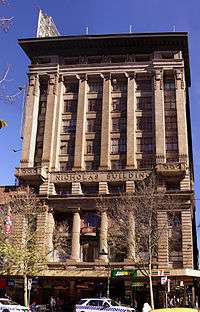Nicholas Building

The Nicholas Building was home to businesses associated with the Flinders Lane garment trade, commercial artists, medical practitioners and architects, in the city of Melbourne, Australia. It is located at 37 Swanston St, at the intersection of Swanston Street and Flinders Lane in the heart of the city. It was designed by architect Harry Norris and built for Alfred Nicholas. The building was completed in 1926 and the architecture style was influenced by the 'Chicago Style' of architecture.[1] The Nicholas Building includes shops, restaurants, artist studios, jewellers and the like.[2]
History
The Nicholas brothers were the original owners, who found wealth in reinventing aspirin after the original patent was suspended post-World War I. The Nicholas company never occupied the building; it was instead built as a speculative office building development. It was completed in 1926 by architect Harry Norris and was the grandest 1920s palazzo in the city.[3] Harry Norris himself also ran a business in the building, until the mid-fifties. From 1926 to 1967 a Coles department store occupied the basement and ground floor, making it the oldest store in Melbourne. The building was home to businesses associated with the Flinders Lane garment trade, commercial artists, medical practitioners and architects. Nowadays the building is occupied by artist studios, jewellers and the like.[1]
The novel Shantaram, written by one of Australia’s most wanted fugitives Gregory David Roberts, was written in the building.[4] In 2003 it is believed a stencil by UK artist Banksy was painted on the building at the corner of Swanston St and Flinders Lane; a piece of plastic was put up over the piece to protect it from the elements but was later painted over by vandals causing a disturbance in the art community.[5]
The Nicholas Building was home to the last manually operated elevator in Melbourne before undergoing modernisation and was driven by Daniel Devon during its final stages making him the last elevator operator in Melbourne.
Architecture

The Nicholas Building was built in a time of imposed height restrictions that lasted from 1916 to 1957 and stated a limit of 132 ft (40.3 m). It consists of 10 floors and is influenced by the Chicago style evident in Melbourne at the time. It has a terracotta faience façade which was designed to self-clean; the grey terracotta manufactured as ‘Granitex’ by Wunderlich was used due to its durability and ease of maintenance. The exterior has signs of a Greek revival style in its façade treatment, which uses ionic pilasters to divide the upper façade into bays and giant ordered columns defining the lower half.[6]
The Nicholas Building was home to the last manually operated elevator in Melbourne before undergoing modernization and was driven by Daniel Devon during its final stages making him the last elevator operator in Melbourne.
A structured steel frame was used for the first 3 floors with reinforced concrete on the upper floors. The interior was planned around a lighting well, and the top 6 floors are utilitarian spaces which are now used as studio spaces. It is said to have the only remaining example of lead-light roofed and fan-lighted arcade in Melbourne, which is situated on the ground floor and offers access to Swanston St.
The Nicholas Building incorporated the latest technology of its time, and a few surviving features can still be seen today, including a mail chute that carried letters down from upper floors.[4][7]
It is listed by the National trust and is also heritage listed.[1]
See also
References
- 1 2 3 "Nicholas Building - 21-47 Swanston Street. Melbourne. Walking Melbourne Building Information". Retrieved 19 Apr 2012.
- ↑ "Nicholas Building". Retrieved 19 Apr 2012.
- ↑ Goad, Phillip (2011). Encyclopedia of Australian Architecture. United Kingdom.
- 1 2 "The Lifted Brow – Anna Krien on the Nicholas Building". Retrieved 19 Apr 2012.
- ↑ Apr 2012 "City does give a rat's for Banksy's wiped-out art" Check
|url=value (help). - ↑ "Nicholas Building (Heritage Listed Location): On My Doorstep". Retrieved 19 Apr 2012.
- ↑ Duffy, Helen (2001). Walking Melbourne. Australia.
External links
![]() Media related to Nicholas Building at Wikimedia Commons
Media related to Nicholas Building at Wikimedia Commons
Coordinates: 37°49′00″S 144°58′00″E / 37.8167°S 144.9668°E